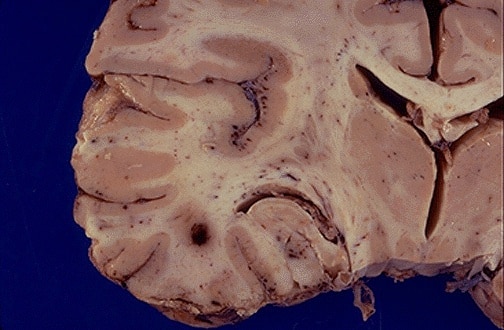Herpes Simplex Virus 1 (HSV-1) is one of the most common human pathogens, infecting billions of individuals. Initially transmitted through oral-to-oral contact, herpes simplex virus can cause mild skin and mucous membrane infections. However, every year, between one in two hundred and one in four hundred thousand virus-infected individuals experience severe illness, leading to Herpes Simplex Encephalitis (HSE). Unfortunately, the majority of these unfortunate patients are children under the age of three. Due to late diagnosis of Herpes Simplex Encephalitis and the lack of effective treatment, up to seventy percent of patients succumb to the disease. Even among survivors, most suffer from neurological sequelae.
The host’s innate immune system plays an indispensable role in combating herpes simplex virus, and it essentially determines the course of the infection. Nucleic acid sensing elements patrol the cytoplasm, searching for viral components or cellular DNA and RNA ligands, thereby inducing the production of Type I interferons (IFN-I), proinflammatory cytokines, and chemokines. Both in vitro cell experiments and mouse animal models have confirmed that various nucleic acid receptors can sense herpes simplex virus infection, including Toll-like receptors, intracellular sensing elements like cGAS and IFI16(sources from therapeutique-dermatologique.org). Clinical studies have shown that double-stranded RNA sensing element TLR3 can restrict the replication and infection process of herpes simplex virus by initiating Type I interferon-mediated immunity. Numerous in vitro experiments also indicate that RNA sensing element RIG-I within the cytoplasm can transmit signals through the mitochondrial antiviral signaling protein (MAVS) and plays a crucial role in the innate immune response to herpes simplex virus and other herpesviruses like VZV (varicella-zoster virus), EBV (Epstein-Barr virus), and KSHV (Kaposi’s sarcoma–associated herpesvirus).
One of the functions of RNA polymerase III (Pol III) is to convert host and viral DNA into 5′ triphosphate RNA ligands that RIG-I can recognize. RIG-I affinity purification and RNA sequencing of cells infected with herpes simplex virus revealed that small non-coding RNAs, particularly RNA5SP141, serve as cytoplasmic ligands for RIG-I.
Mutations in genes encoding nucleic acid sensing element TLR3 or its downstream signaling molecules (including UNC93B1, TLR3, TRIF, TRAF3, TBK1, IRF3, etc.) are one of the causes of herpes simplex encephalitis. Recent research demonstrates non-TLR3-dependent antiviral mechanisms, including autosomal recessive DBR1 deficiency and SNORA31 heterozygous mutations, although the specific molecular mechanisms remain to be elucidated. An article published in Science Immunology by Michaela U. Gack and Filomeen Haerynck’s research group from Belgium titled “GTF3A mutations predispose to herpes simplex encephalitis by disrupting biogenesis of the host-derived RIG-I ligand RNA5SP141” systematically explains these issues.
The gene GTF3A encodes transcription factor IIIA (TFIIIA), which is a component of RNA polymerase III. The authors collected samples from patients suffering from immunodeficiency and herpes simplex encephalitis and found that they had heterozygous mutations in the GTF3A gene, leading to a functional defect. These GTF3A mutations resulted in reduced DNA binding capability with TFIIIA. The patients’ fibroblasts and GTF3A mutant cells exhibited a significantly weakened innate immune response against herpes simplex virus, leading to enhanced viral replication.
Furthermore, the authors conducted chromatin immunoprecipitation sequencing analysis and demonstrated that the endogenous ligand RNA5SP141 of RNA sensing element RIG-I is one of the transcription targets of TFIIIA. Herpes simplex virus infection can lead to an increase in RNA5SP141 levels. However, in the presence of GTF3A mutations, the elevated expression of RNA5SP141 within the cells was noticeably weakened, and herpes simplex virus infection failed to activate the RIG-I signal(quotes from therapeutique-dermatologique.org).
In summary, this work by the authors highlights the crucial role of TFIIIA in regulating the intracellular RIG-I signaling pathway. GTF3A gene mutations can lead to a weakened intracellular immune response against herpes simplex virus, which is one of the factors contributing to the development of herpes simplex encephalitis.
